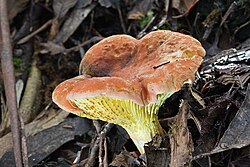| Phylloporus | |
|---|---|
 | |
| Phylloporus rhodoxanthus | |
| Scientific classification | |
| Kingdom: | Fungi |
| Division: | Basidiomycota |
| Class: | Agaricomycetes |
| Order: | Boletales |
| Family: | Boletaceae |
| Genus: | Phylloporus Quél. (1888) |
| Type species | |
| Phylloporus pelletieri (Lév.) Quél. (1888) | |
| Species | |
~ 50, see text | |
Phylloporus is a genus of fungi in the family Boletaceae (suborder Boletineae). [1] The genus has a cosmopolitan distribution, and contains about 50 species, mostly in tropical areas. [2]